Abstract
The aim is to improve primary physical education process based on the use of means and methods into capacity-building athletic conditional. Along with driving skills, driving skills must be the primary objectives of the physical education lesson content. Regardless of the material conditions (room, devices, materials) or weather (rain, snow, fog, cold), development of motor skills should be first. It is preferred that the lesson of physical education, physical attributes are not placed at random. Rank actions for developing motor skills in physical education class must be determined depending on the nature of that effort in order to ensure optimal volume or intensity and ensure the return of the body. School athletics is athletics during the initiation, which, from the earliest years of school children begin to learn the basic mechanisms specific athletic evidence. These are important for the influence they have both in developing basic motor skills, but also in developing the child's motor skills for daily activity, it’s natural that you have athletic exercises. As such athleticism is one of the core subjects in school physical education (
Keywords: Athleticsprimary; speed; strength; resistance development
Introduction
I decided to tackle this issue as they have the means and knowledge sufficient to amount to a
higher rank knowledge already gained in this field at both theoretically and practically. The knowledge
obtained through studies at higher level, encouraged me to try and fail as I will demonstrate and give new
meanings to this branch of athletics. Also I liked and I was always fascinated by sport in general and I
toyed with different sports including athletics which I moved, and I determined to realize research in this
to help through the means available to develop this area.
Content, Methodology
In the specific literature, the term track is defined as a "system of exercises designed as running,
throwing and jumping natural and stylized, in order to develop specific physical qualities and obtain a
higher result in their practice(Alexe, 1993), (Ardelean, 1982), (Cârstea, 2000), (Mihailescu, 2006), (
Mitra, 1977). " The ancient Greeks "athletes" were those people who were preparing specifically for the
purpose for winning a prize in a contest. The term used in literature, athletics is athletics (British English)
and track and field (American English) or samples on the track (track - jogging) and field samples (field - jumping and throwing). Athletics competitions include groups of samples and samples that have specific
characteristics, according to the three fundamental categories of exercise or running, jumping and
throwing. Anyway ordered these exercises, they do not change the general meaning and essential motor,
which we express notions of running, jumping and throwing. In school curricula at all grades and in the
sports activity of students and soldiers, athletics is currently in physical education lessons or sports
training (Ionescu-Bondoc, 2007), (Programele scolare, 2001).
Unlike traditional education, centered on knowledge, the distribution of knowledge in the modern
school education rise much above the level of mere knowledge, mere transmission and assimilation of
knowledge. The main concern now is to make knowledge a function of engine of development thinking,
attitude and behavior training, promoting the personal development of the student (
2001).
The means of capacity building generally used conditional and specific athletes
Making full use of exercises:
• running school
• jumping school
• disposal school
• balance school
Quality basic motive:
• reaction speed, movement and execution of motor acts, single and repeated
• explosive force and maximum force large muscle chains
• mixed aerobic and resistance efforts
• complex coordination segments from the body and body in space, time and handling guidelines
Objects
Specific motor qualities:
• speed, strength, stamina, agility, mobility manifestations of samples in each group their combined
forms of expression.
Methods and means of development:
• maximum power, explosive;
• the rate of reaction completion, the repetition of the movement
• a mixed aerobic and resistance efforts
• the skill
• mobility and suppleness
Methods / growth:
• active muscle
• trophy
• tonicity
Research Methods
There were used the following methods:
1. Method literature study which consisted of gathering information and documentation necessary
to substantiate theoretical work.
2. Method teaching observation - is to follow and accurate recording of events intended subjects.
3. Experimental method
4. The method of measurements and tests
Subjects included in the research
Class III children with a staff of 15 subjects, of which eight girls and seven boys were components
of the study that I conducted this school.
Test and measurement
Test tools that we used during the study were a few tests that I will present below:
- running speed on the distance of 25 m; (A.V.)
- long jump from place; (S.L.)
- throwing the Oina ball; (A.M.O.)
- running resistance on the distance of 600 m (A.)
Means used
The means we used in school running exercises such as running faster, running in moderate
tempo; school throwing exercises such as type flinging throws, throws release type; school jumping
exercises, jumping in place and make traveling, step leap, skip steps and combinations of steps.
Findings
Results obtained in initial and final testing, statistical interpretation and analysis of experimental
results.
During the study were conducted two tests. An initial test that was conducted at the beginning of
the school year respectively on 21 September 2015 and a final test at the end of the school year, namely
on the date of May 31, 2016.
When the survey was made a comparison between the results of the initial test and final test results
to highlight the effectiveness of means and methods used in physical education lessons.
Following the measurements motive applied to the female students and students of class III we
have obtained some data that we have evaluated according to certain criteria, assessing the level at which
the subjects investigated are at and to what extent exercises used were motility had on their efficiency.
Analyzing data obtained by calculating averages for both initial testing and final as it can be seen
an improvement in results in all samples applied to both girls and boys, thus confirming the assumption
made.
To judge the effectiveness of athletics content, we do an analysis on each sample, compared to
initial testing, final testing.
In Figure
difference between initial and final
testing has decreased by 0.2-0.4 seconds.
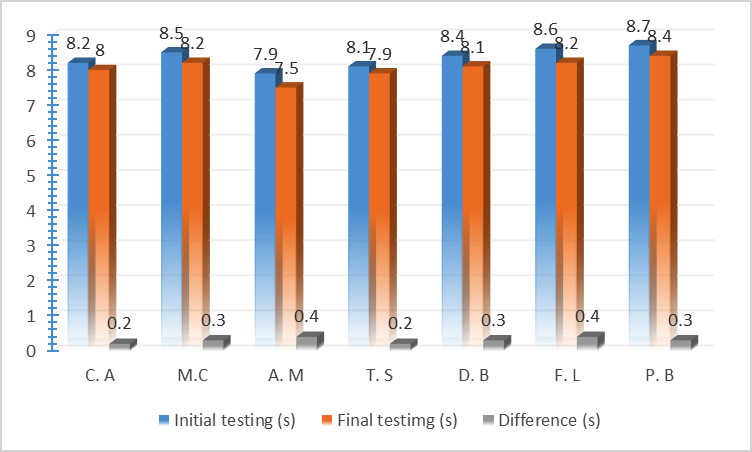
In Figure
difference between initial and final
testing has decreased by 0.2-0.4 seconds.
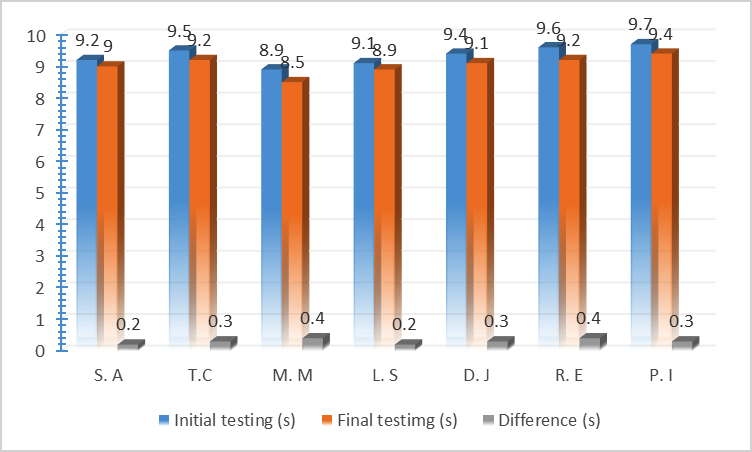
In Figure
difference between initial and final
testing has increased by 0.05-0.2 metres.
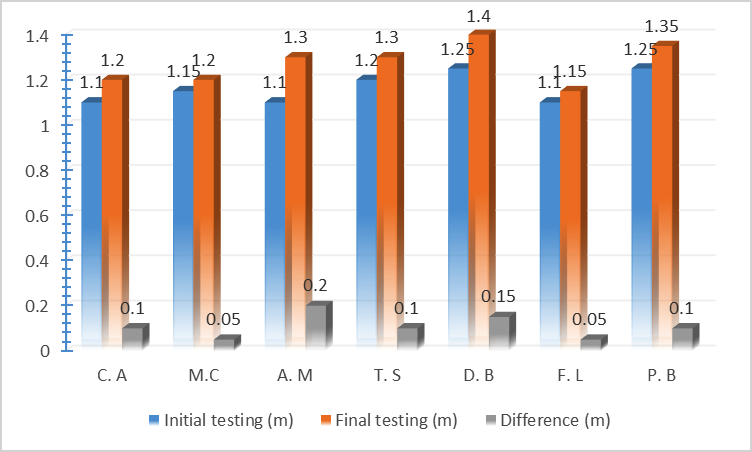
In Figure
difference between initialand final
testing has increased by 0.011-0.2
metres.
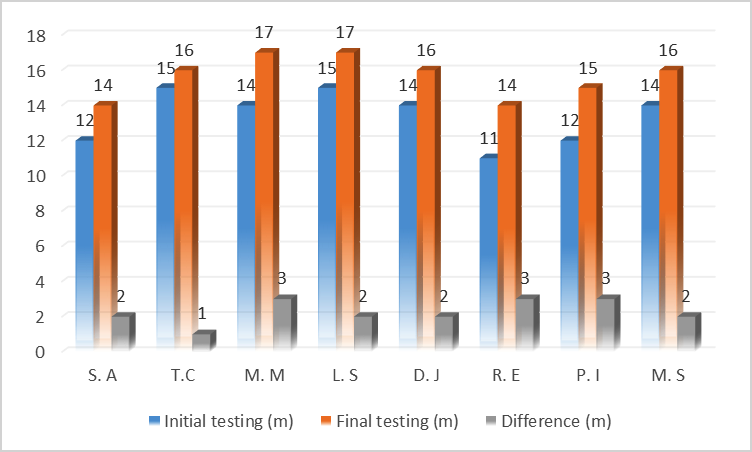
In Figure
difference between initial and final
testing has increased by 1-5 metres.
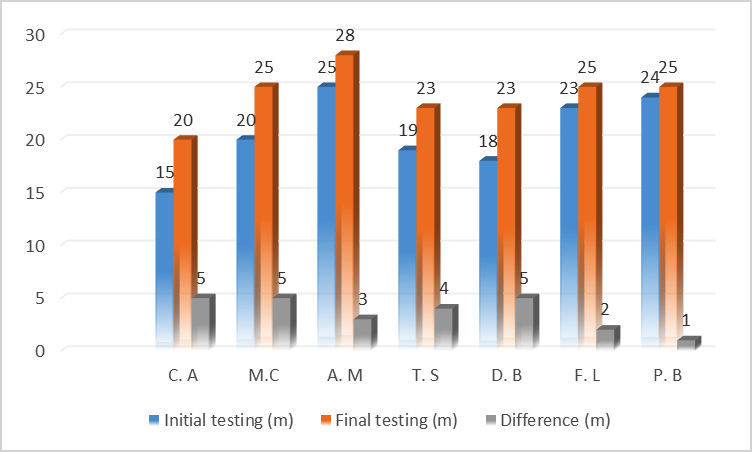
In Figure
difference between initial and final
testing has increased by 1-3 metres.
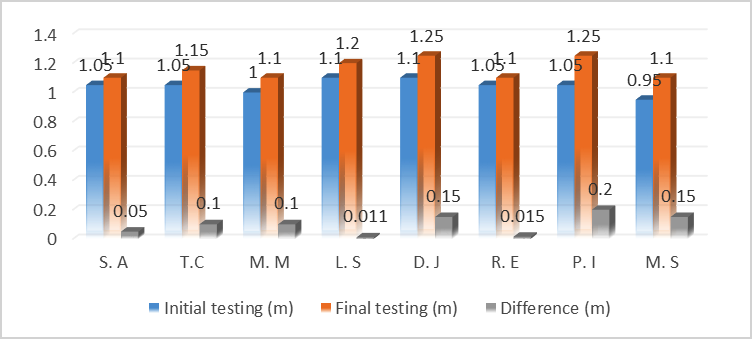
In Figure
difference between initial and final
testing has decreased by 5-10 seconds.
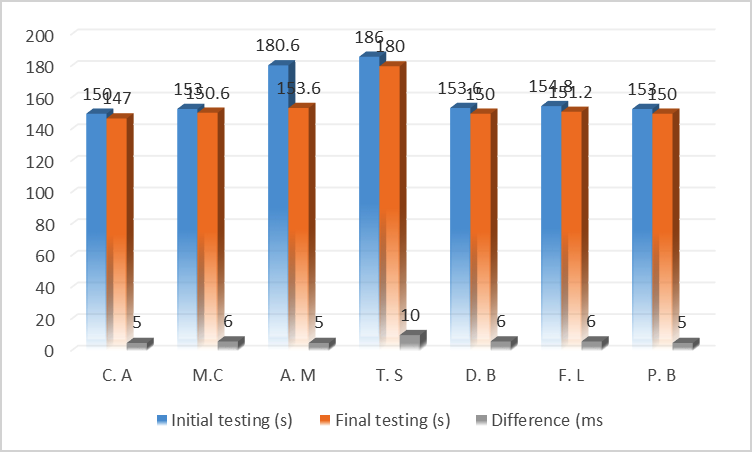
In Figure
difference between initial and final
testing has decreased by 2-10 seconds.
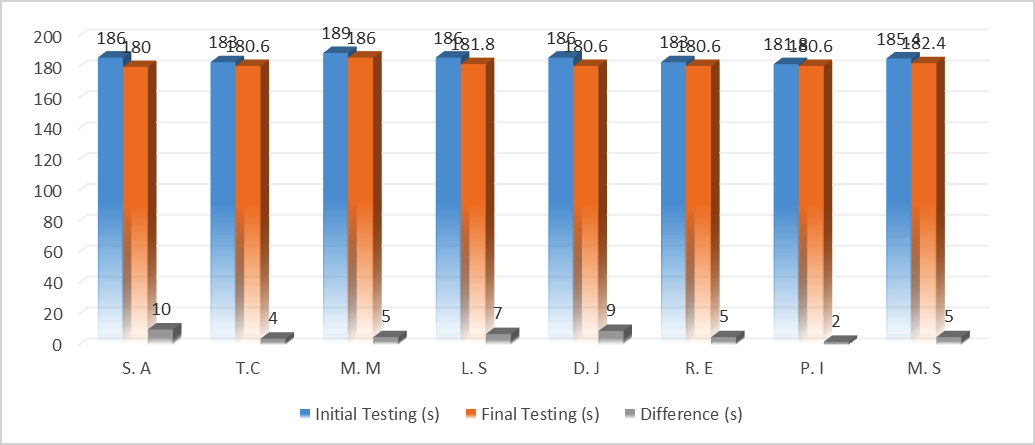
Conclusions
Along with driving skills, driving skills are paramount objectives of the physical education lesson
content. Regardless of the material conditions (room, devices, materials) or weather (rain, snow, fog,
cold), motor skills education is essential. It indicated that physical education class, physical attributes are
not arranged at random. Rank actions for developing motor skills in physical education class must be
determined depending on the nature of that effort in order to ensure optimal volume or intensity and
ensure the return of the body. Speed and skill development will be placed after link Third lesson
(selective influencing the musculoskeletal system) and strength and endurance will be placed before the
linker recovery of the body after exercise. Optimal age influence on the development of motor skills
favorable mention that speed can be developed with very good results at age 10-12 years but the work of
educating speed in its various forms can begin 5-6 years. Develop better skills among the same age as the
speed limit. Strength and endurance, driving skills more easily improvable can educate systematically 9-
10 years with an upward trend and maximum opportunity for improvement. It notes that following the
work carried out, driving qualities required physical education lessons are strongly influenced, they can
be found also in the final evaluations, general skills and performance standards being achieved at a higher
level. We conclude that all four samples absolutely all subjects have been improvements in the results
from the final testing compared with the initial and increases performance were some significant, for
which certifies that the exercises in athletics schools used in physical education lessons clearly and
effectively improve conditional abilities. The control samples, came interest from the students and the
teacher to obtain final grades good and very good, leading to a better manifestation of physical qualities
speed through its forms, better strength and skill demonstrated by the results both groups of subjects
investigated.
References
- Alexe, N. (1993). Antrenamentul sportiv modern. Editura Editis.
- Ardelean, T. (1982). Particularităţile dezvoltării calităţilor motrice în atletism. IEFS.
- Cârstea, Gh. (2000). Teoria şi metodica educaţiei fizice şi sportului. Editura AN-DA.
- Cârstea, Gh. (1993). Teoria şi metodica educaţiei fizice şi a sportului. Editura Univers.
- Ionescu-Bondoc, D. (2007). Poliatlonul atletic şcolar. Editura Universităţii Transilvania Braşov.
- Mihailescu, L.; Mihailescu, N. (2006). Atletism în sistemul educaţional, Editura Universităţii Piteşti.
- Mitra, Gh., Mogoş, A. (1977). Dezvoltarea calităţilor motrice. Editura Sport-Turism.
- Ministerul Educaţiei şi Cercetării Ştinţifice. (2001). Programele şcolare pentru învăţământul primar - disciplina educaţie fizică şi sport. Editura Didactică şi Pedagogică.
Copyright information

This work is licensed under a Creative Commons Attribution-NonCommercial-NoDerivatives 4.0 International License.
About this article
Publication Date
25 May 2017
Article Doi
eBook ISBN
978-1-80296-022-8
Publisher
Future Academy
Volume
23
Print ISBN (optional)
-
Edition Number
1st Edition
Pages
1-2032
Subjects
Educational strategies, educational policy, organization of education, management of education, teacher, teacher training
Cite this article as:
Constantin, A. M. (2017). Athletics Content In Primary School And The Role On Conditional Capacity Development. In E. Soare, & C. Langa (Eds.), Education Facing Contemporary World Issues, vol 23. European Proceedings of Social and Behavioural Sciences (pp. 1447-1455). Future Academy. https://doi.org/10.15405/epsbs.2017.05.02.177

